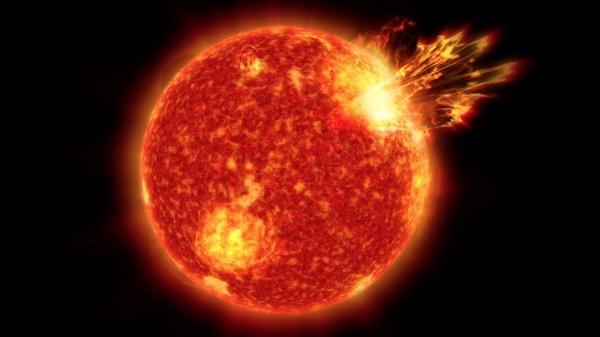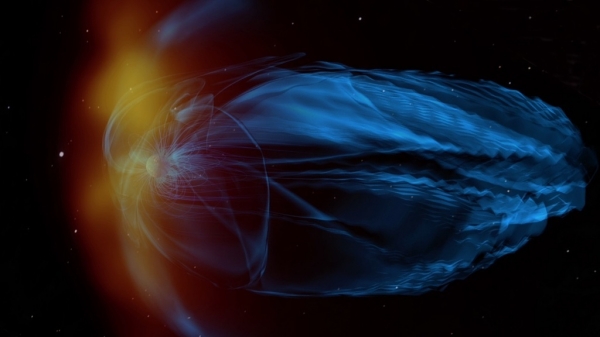Vladimir Airapetian, senior astrophysicist in the Heliophysics Division at NASA’s Goddard Space Flight Center, has a somewhat unusual ambition. Most attention related to finding a ‘second Earth’ revolves around locating a world not only similar to ours in its characteristics but also similarly situated in terms of its host star’s evolution. In other words, a rocky world scorched by its star’s transition to red giant status isn’t a true analogue of our own, but a glimpse of what it will be at another stage.
What Airapetian has in mind, though, is going in the other direction. His projected Earth analogue is one that mimics what our planet was in its early days, not all that long after the birth of its stellar system. It’s an ambition that points to learning where we came from, and thus what we might expect when we see a system like ours evolving around other stars. It has led to a search for a star like the Sun in its infancy. Says Airapetian:
“It’s my dream to find a rocky exoplanet in the stage that our planet was in more than 4 billion years ago, being shaped by its young, active star and nearly ready to host life. Understanding what our Sun was like just as life was beginning to develop on Earth will help us to refine our search for stars with exoplanets that may eventually host life.”

Image: Illustration of what the Sun may have been like 4 billion years ago, around the time life developed on Earth. Credit: NASA’s Goddard Space Flight Center/Conceptual Image Lab.
Space-based instruments have provided data, as the GSFC team studied existing solar models for insight into the characteristics of the young star Kappa 1 Ceti, about 30 light years away. Data input from Hubble, TESS (Transiting Exoplanet Survey Satellite), NICER (Neutron star Interior Composition Explorer, installed aboard the ISS) and the European Space Agency’s XMM-Newton observatory have refined the model.
Kappa 1 Ceti is a G-class star in the constellation Cetus with a rapid rotation of about nine days. Our Sun rotates in 27 days, but in its youth is thought to have rotated three times faster. The mass of the two stars is roughly the same, and Kappa 1 Ceti has 95 percent of the Sun’s radius, with about 85 percent of its luminosity. An early Sun would have had a stronger magnetic field and a powerful solar wind, which would have affected the magnetosphere and thus atmospheric chemistry on the young Earth.
Consider: Earth in its infancy, though receiving less solar heat than today, would have been subject to more high energy particles and radiation from the young Sun. High solar activity would cause particles to slam into Earth’s nitrogen atmosphere, wreaking molecular change: Breaking nitrogen molecules into atoms and turning carbon dioxide into its carbon and oxygen constituents. Nitrogen paired with free oxygen gives nitrous oxide, which produces a greenhouse effect boosting the planet’s temperatures and perhaps assisting the formation of life.

Image: An artist concept of a coronal mass ejection hitting the young Earth’s weak magnetosphere. Credit: NASA/GSFC/CIL.
Airapetian’s team used the Alfvén Wave Solar Model, developed within a larger model of space weather originally created at the University of Michigan, described in the paper as “a first-principles global model that describes the stellar atmosphere from the top of the chromosphere and extends it into the heliosphere beyond Earth’s orbit.”
Data inputs include known information about a star’s magnetic field and data on its ultraviolet emissions, both of which can be used to predict otherwise unobservable stellar wind activity. The team tested its model against data on the Sun to validate its predictions, finding that it successfully tracks the Sun’s solar wind and corona.
The model allows the researchers to predict the effects of a star’s stellar wind and corona on its magnetic shield, with effects on potential habitability. The key finding: In addition to the kind of coronal mass ejection (CME) events that blow plasma outward from the star and can produce atmospheric loss on young planets, we also find what are known as Corotating Interaction Events (CIRs) that can directly impact such worlds.
The young star produces a dynamic pressure 1380 times what is produced by these same CIRs in our own mature Sun. The effects would be significant::
This is a very important result as CIRs cause magnetic storms on Earth… The initiation of magnetic storms is associated with enhanced dynamic pressure that compress[es] the Earth’s magnetosphere and cause[s] the induction of ionospheric currents and results in Joule heating of the ionospheric and thermospheric layers of the planet.
The changes in the magnetosphere produced by these CIRs are comparable to the strongest coronal mass ejections, with results including strong fluxes of electrons and protons into the upper atmosphere:
These processes can be crucial in evaluating the magnetospheric states of exoplanets around active stars because induced current dissipation will enhance the atmospheric escape from Earth-like exoplanets around active stars and can be critical for habitability conditions for rocky exoplanets in close-in habitable zones around red dwarfs.
Airapetian and team have developed a way of modeling the stellar environments in a range of young G- and M-class stars. We can look toward future mapping of stars at various stages of their lives. The researchers specifically mention their interest in EK Dra, a 100 million year old star 111 light years out that is producing more flares and plasma than Kappa 1 Ceti.
While Airapetian says his team’s work involves “looking at our own Sun, its past and its possible future, through the lens of other stars,” it also points in the other direction as a way of examining infant exoplanet systems where life may have the potential for developing, and thus guiding our list of targets for future observing efforts
The paper is Airapetian et al., “One Year in the Life of Young Suns: Data-constrained Corona-wind Model of ?1 Ceti,” Astrophysical Journal Vol. 916, No. 2 (3 August 2021), 96 (abstract / preprint).



The analysis seems to suggest that conditions on the early earth were far less favorable for the emergence of life. Abiogenesis must either have been protected from such conditions on the surface, or abiogenesis must have occurred after the sun became less active, allowing surface conditions on Earth to stabilize.
I am not seeing any obvious time period for these effects in the paper, but I assume that the first signs of life after the LHB on Earth occurred after the sun had become less active.
What might be interesting is whether enough N2O could be formed to mitigate the problem of the lower luminosity of the sun which would imply a frozen early Earth after the heat of formation and bombardment was lost and the surface cooled. Has anyone modeled whether N2O, CH4, and CO2 could keep the Earth’s surface warm enough?
Yes, we did develop an atmospheric chemistry model to study the production of nitrous oxide and biomolecules driven by the activity of the young Sun following my earlier paper in Nature Geo 2016.
Thank you for this, Dr. Airapetian. It’s a pleasure to have you here.
The Earth was warm enough when life began because there was much less carbon dioxide and nitrogen in our atmosphere. This paper says our early atmosphere was up to half or 50 percent carbon dioxide which would make it warm enough. https://earthsky.org/earth/earth-ancient-atmosphere-carbon-dioxide-nitrogen-meteorites/ I agree with the micrometeorites, but not with the idea that our early atmosphere was lower in pressure. The reason is our Sun was 40 to 20 percent less brighter from 4 to 2.7 billion years due to hydrogen burning over time. Consequently, we don’t need a thinner atmosphere to keep the temperature cool enough if their was more carbon dioxide since our Sun was less bright.
Also the Earth had a faster rotation in the past, so there was still a slightly stronger magnetic field 4 billion years ago. A more active Sun would cause more radiation, but CME’s and the solar wind would still be trapped in the magnetic field. Early life would be protected. Ultra violet radiation would still be there and a high enough level of ozone would have to be made by life in order for life to life safely on land. Also it should be clear that such a large amount of carbon dioxide was removed over a long period of time by life through photosynthesis and the carbon cycle.
I am using Kasting’s work on Earth’s paleo climate. In his 1988 book “How to find a habitable planet” the figure 3.1 shows that climate models indicate that the Earth would be frozen up to 1 bya. That the evidence indicates that this is not the case is the “faint young sun problem”. Subsequent work by kasting and others have suggested various possibilities including a dense H2 atmosphere in addition to the dense CO2/N2 atmosphere.
AFAIK, because N2O is such a minute fraction of the Earth’s atmosphere and has a short residency time, it is not been used in models, despite it being 300x as potent a GHG as CO2. The suggestion that the early activity of the sun might just have generated a lot more N2O seems like a possibility to model as a potential answer to the early climate assuming that it can be continually generated. It is pure speculation on my part, and the timing and amounts may not be adequate as even a partial explanation. But clearly, something kept the early Earth warm and above freezing for life to emerge.
Excuse me for the mistake. The is much less carbon dioxide in our atmosphere today than there was in Earth’s early history. There was more much more carbon dioxide and nitrogen in Earth’s distant past, or 4 to 2.7 billion years ago.
There is no physical problem with Earth’s atmosphere being made of one quarter to half carbon dioxide from 4 to 2.7 billion years ago. The nitrogen is not a problem without life, but nitrous oxide or N2O would be a problem not just because it does not last very long in an atmosphere. Without life an photosynthesis there is no oxygen, so there can be no N2O or nitrous oxide and abiotic oxygen is not enough to make a lot of N2O. Nitrous oxide in addition to being a much more potent GHG than CO2 is another gas that destroys our protective ozone layer, and our over use of nitrogen plant fertilizers is a problem since the denitrifying bacteria convert it into N2O.
I used to think the same thing that there must have been a snowball Earth all the time in the distant past even with the higher levels of carbon dioxide that we know existed in the past after life emerged and in the dinosaur age, but I didn’t think they could be that much higher. Consequently, the Earth was still warm enough even though the solar brightness was 27 to 40 percent less bright 2.7 to 4 billion years ago. The atmospheric pressure could have been the relatively the same as today throughout most of Earth’s history. I don’t buy the idea that it was much thinner.
A star only 100 million years old would not be of any importance because we had the giant impact long after that and life did not evolve until after that time when the solar wind was not that strong. It is still interesting because we don’t know how long it takes life to evolve and whether it can evolve on a world without a Moon and giant impact, but it probably can. It might have to be after the strong solar winds of the young star.